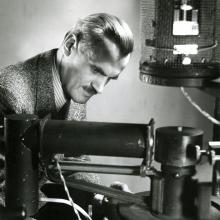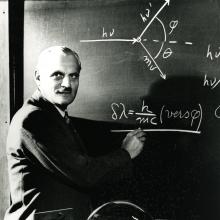Arthur Holly Compton

research apparatus
Arthur Holly Compton (September 10, 1892 – March 15, 1962) was an American physicist who conducted groundbreaking research in Eads Hall here at Washington University in the 1920s. In 1922, as head of the Department of Physics, Compton conducted X-ray scattering experiments that demonstrated the particle nature of electromagnetic radiation. At the time, the idea that light had both wave and particle properties was not easily accepted. Through his research, he explained that each ray behaved as a particle, conserving both energy and momentum in collisions with electrons. This provided the first proof that X-rays—formerly thought to be waves—could also behave as particles, confirming a long-standing, but largely ignored prediction by Albert Einstein. Compton’s discovery stimulated the development of quantum mechanics, and was recognized with the Nobel Prize in 1927.
In the fall of 2022, the Department of Physics celebrated the centennial of that research. There was a display in the lobby at Washington University's Olin Library highlighting him and his research, a lecture by Nobel laureate Frank Wilczek, and the Fall 2022 Saturday Science Lecture Series focused on Compton, his research, and his impact. Associate Professor Erik Henriksen wrote an article about Arthur Holly Compton, "Arthur Compton and the mysteries of light" for the December 2022 issue of Physics Today.
The Compton Centennial Celebration was sponsored by the William C. Ferguson fund.


